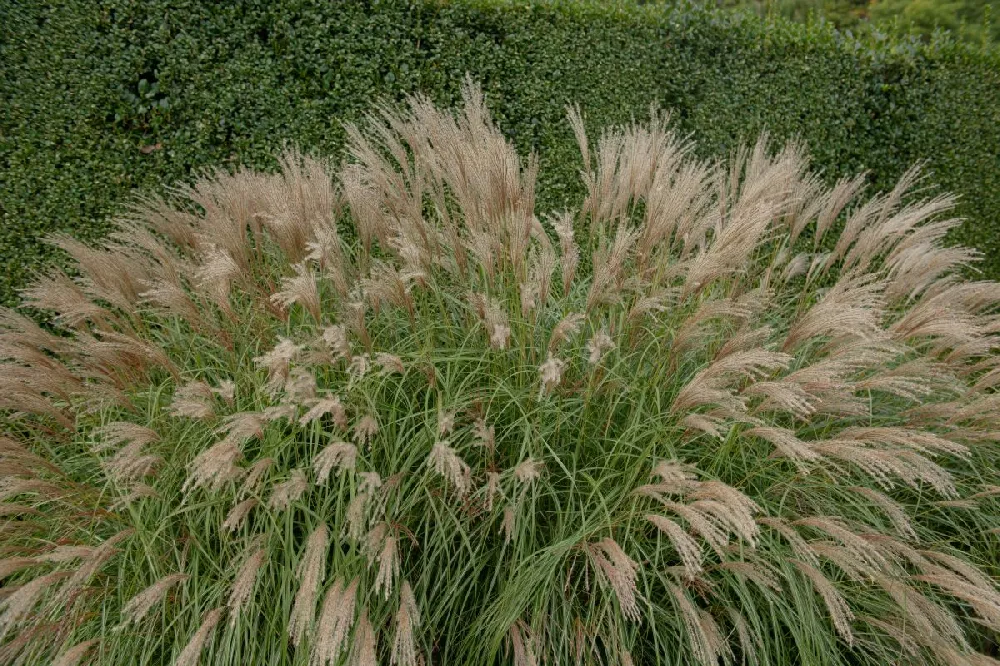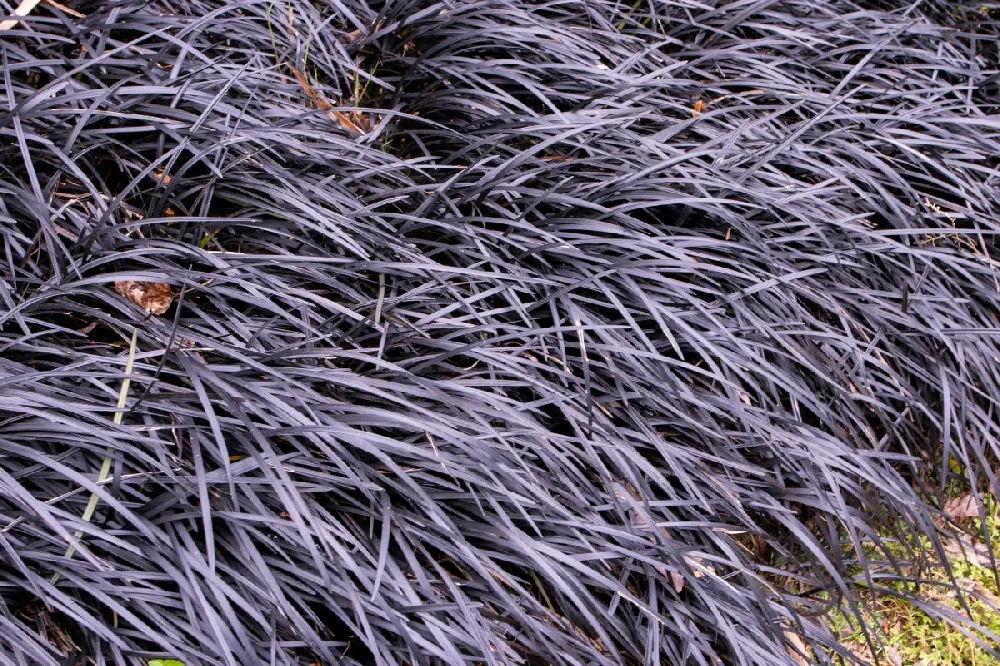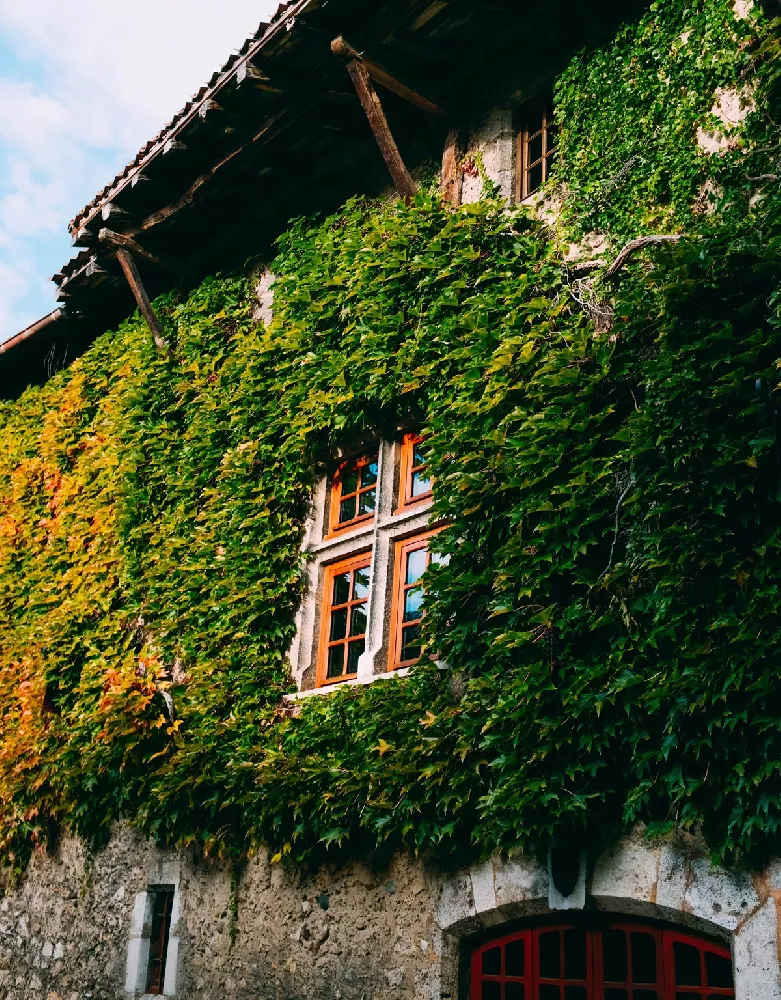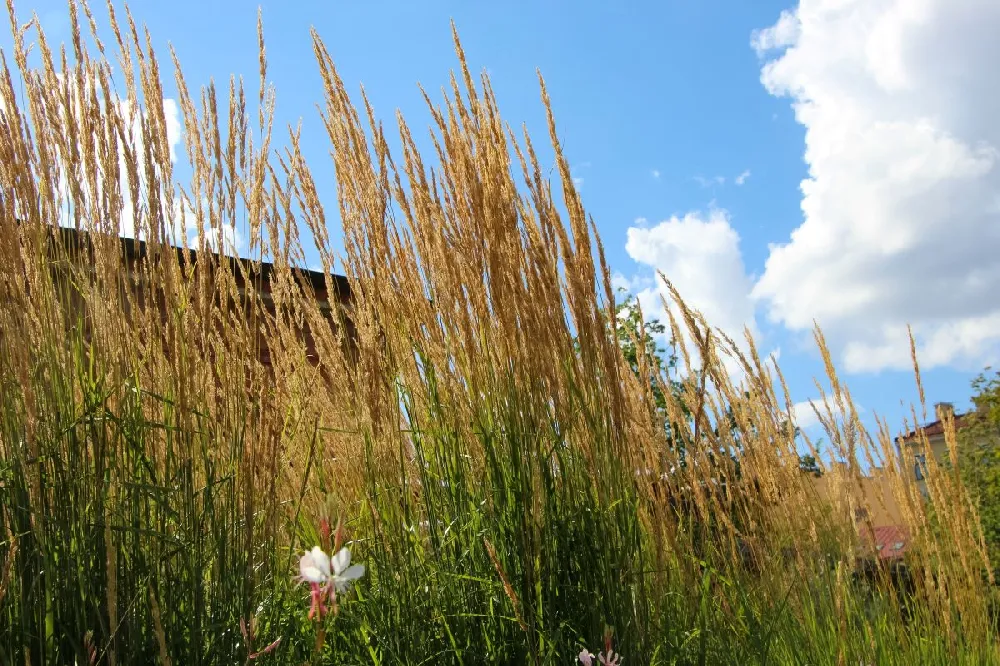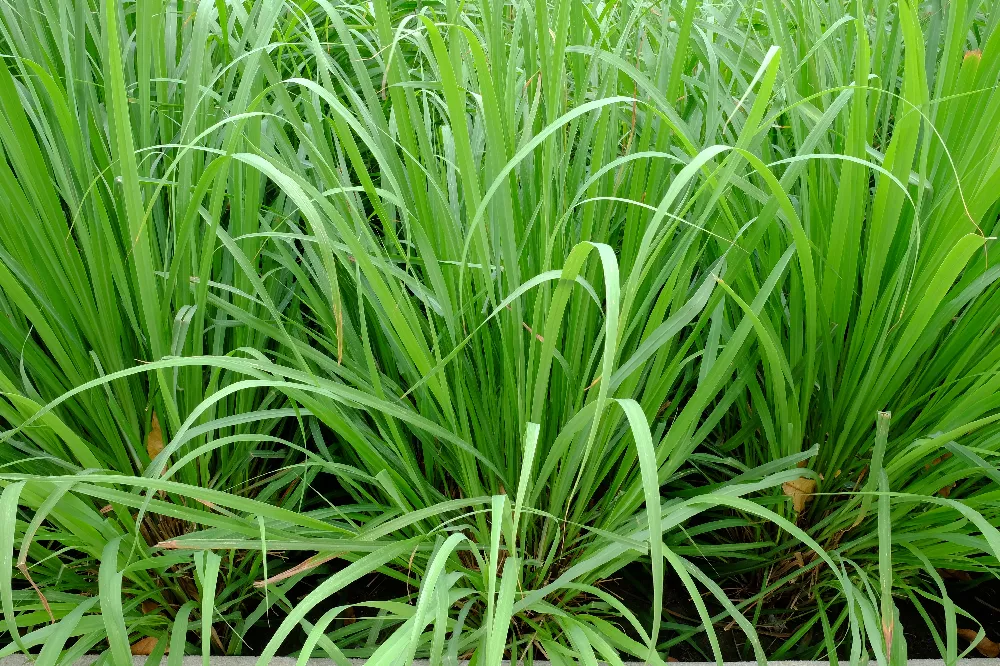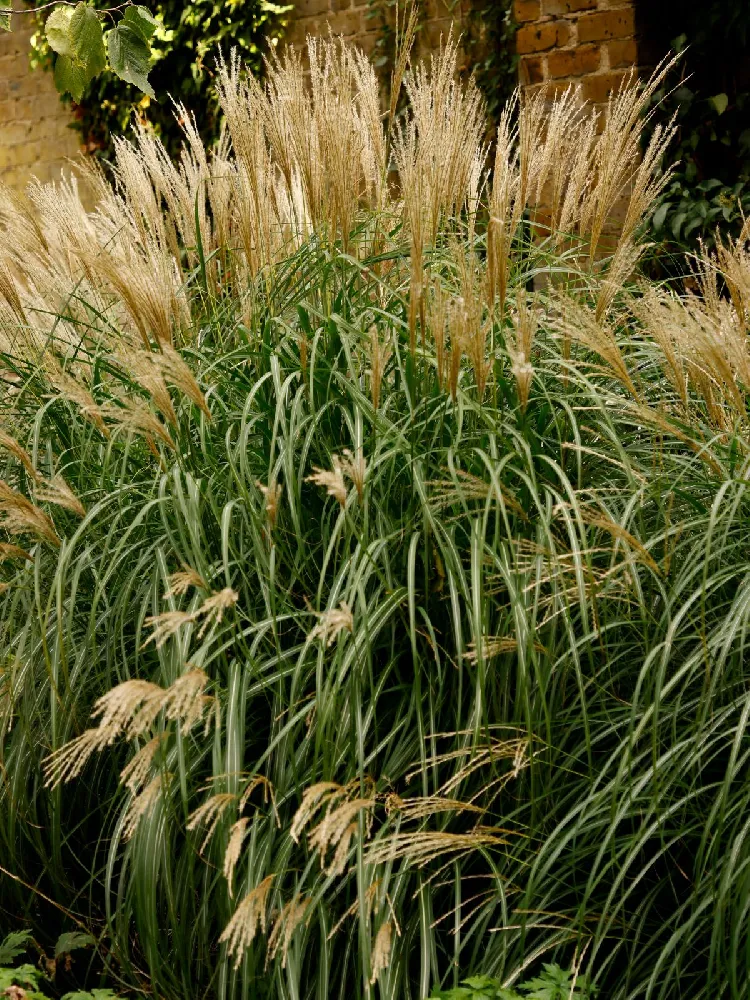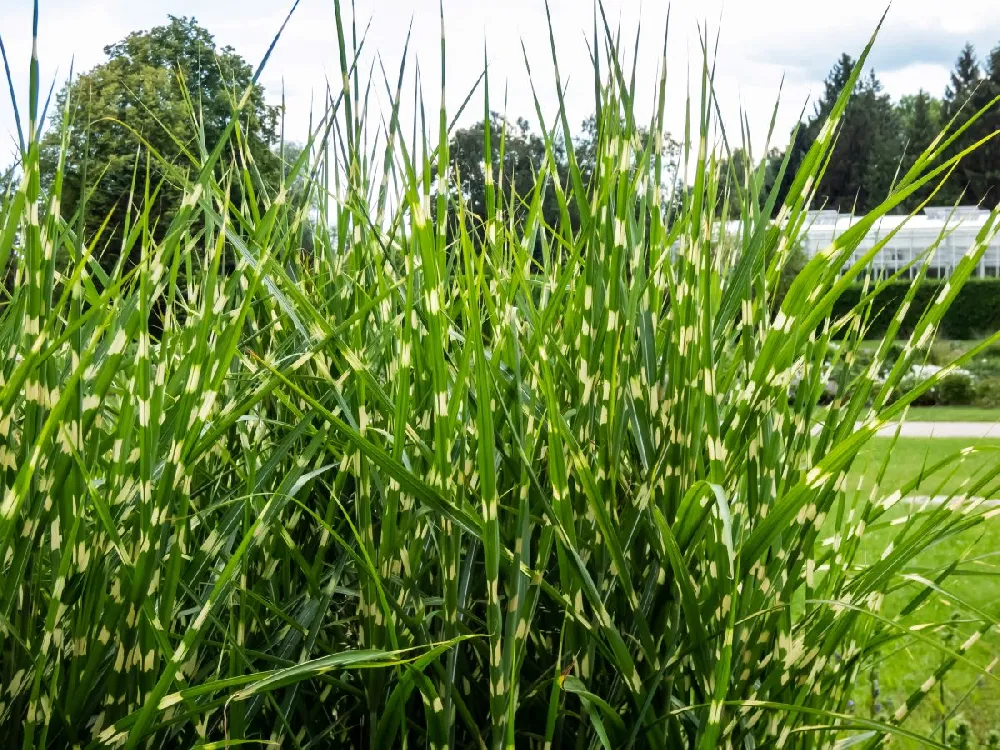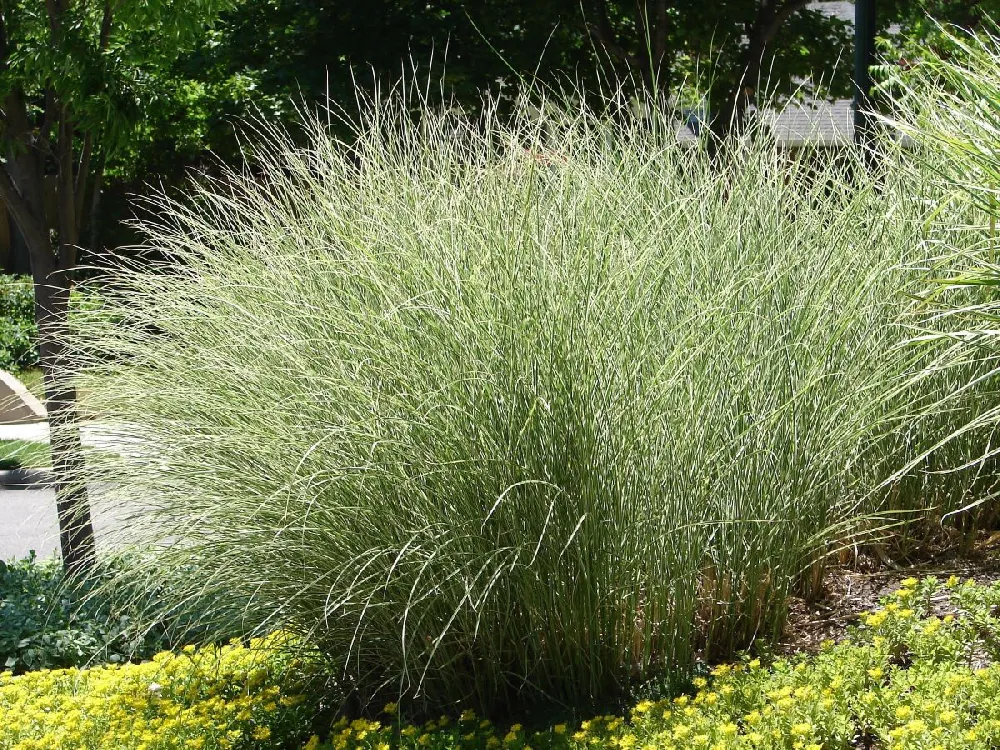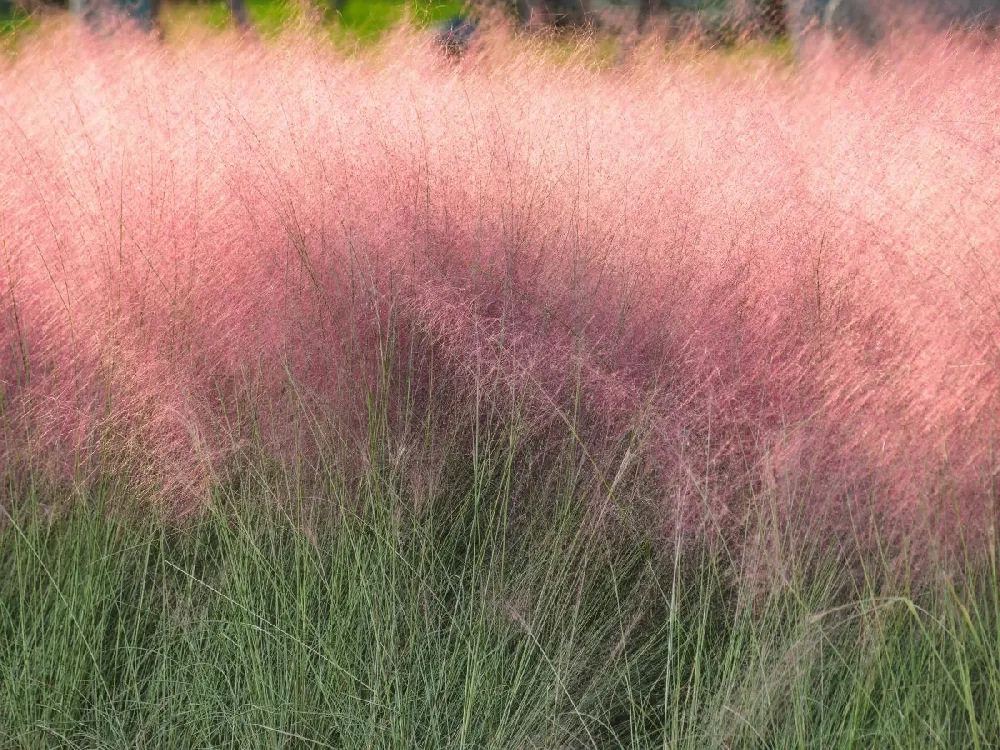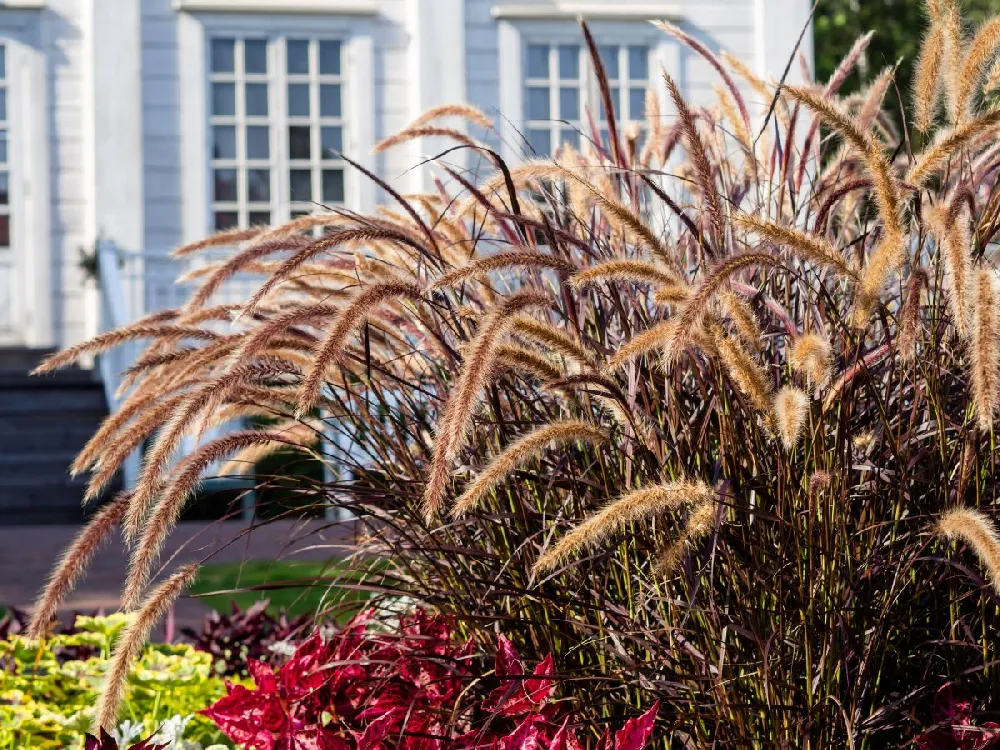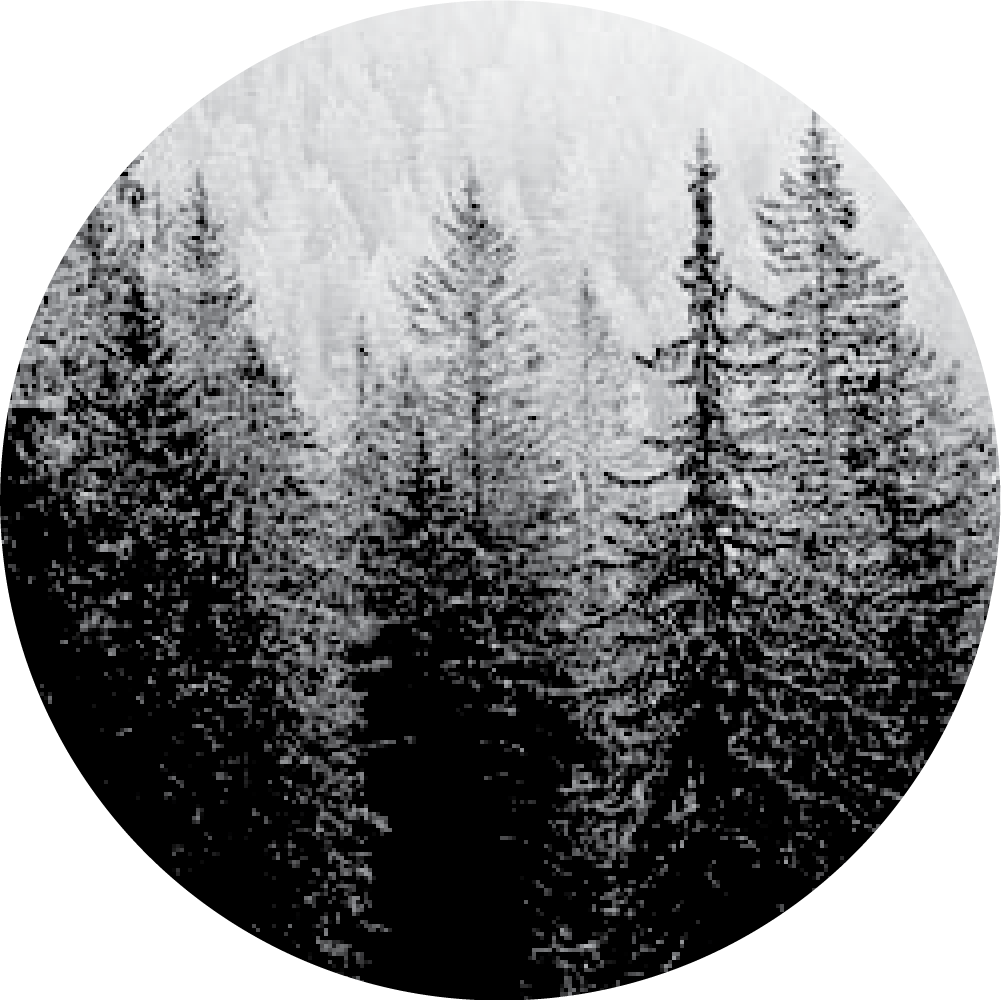- Home >
- Shrubs and Bushes >
- Ornamental Grasses
Ornamental Grasses for Sale - Buying & Growing Guide
24 Results
-
Growing Zone(s): 5-9$54.95
-
Growing Zone(s): 5-10 outdoors$74.95
-
Growing Zone(s): 4-8$54.95
$59.95Save up to 8% -
Growing Zone(s): 4-9 outdoors$34.95
-
Growing Zone(s): 4-11 patio / 9-11 outdoors$94.95
-
Growing Zone(s): 5-9$79.95
$89.95Save up to 11% -
Growing Zone(s): 5-9$34.95
$69.95Save up to 50% -
Growing Zone(s): 5-9$84.95
-
Growing Zone(s): 6-9$49.95
-
Growing Zone(s): 9-11 outdoors$64.95
-
$13.95
$15.95Save up to 12% -
$59.95
$99.95Save up to 40%
Ornamental Grasses – Buying & Growing Guide
Ornamental grasses are often overlooked when people are buying new plants for their garden; however, ornamental grasses have so much to offer. They thrive in a wide variety of conditions where other plants might struggle, including in wet or heavy clay soils, or dry and infertile soils. They are very easy to care for, and after initial planting can often be left and forgotten about, yet will still thrive, making them ideal for beginner gardeners or anyone who likes a low maintenance garden.
16 Types of Ornamental Grasses You Can Grow
1. Reed Grass
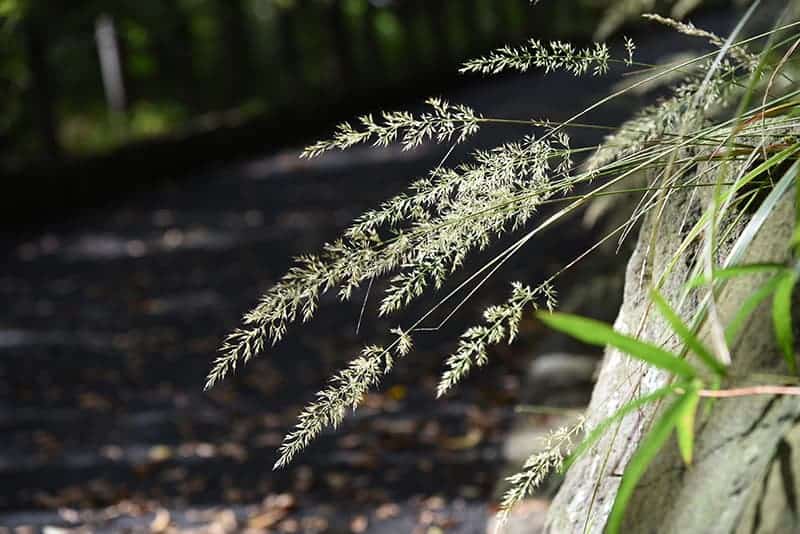
Scientific Name: Calamagrostis brachytricha
Mature Size: Up to 4 feet tall
USDA Hardiness Zone: 4-9
Light: Full sun to partial shade
Water: Average water needs
Soil: Average
Special Features: Award-winning
Varieties: Calamagrostis x acutiflora ‘Overdam’, Calamagrostis x acutiflora ‘Avalanche’
This is a low maintenance perennial grass that spreads slowly. It grows vertically before arching gently at the top to create a mounded shape. The foliage is glossy and green, developing to yellow in the fall. This grass produces flowers in late summer, which take the shape of feathered silver plumes. The plumes develop to golden tan before the seeds ripen in winter; the seeds are sterile and will therefore not self-sow. This grass will tolerate almost any soil type, including clay soil. It does well in wet soils and is therefore popular in naturally moist terrain such as close to ponds and rivers.
2. New Zealand Wind Grass
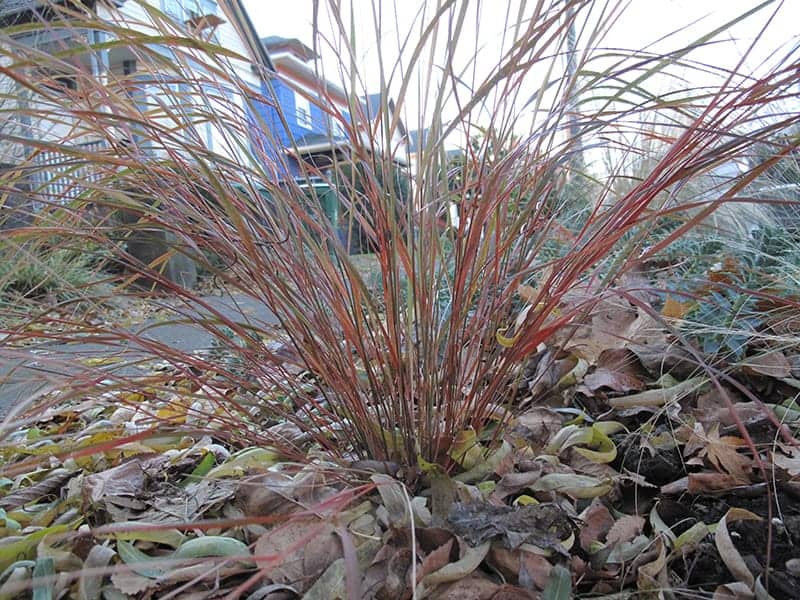
Credit to Megan Hansen
Scientific Name: Anemanthele lessoniana
Mature Size: Up to 3 feet tall
USDA Hardiness Zone: 8-10
Light: Full sun to partial shade
Water: Drought tolerant
Soil: Fertile, well-draining
Special Features: Fast-growing
This semi-evergreen grass forms fountain shaped clumps that are around three feet wide and equally tall. The dark green gently arching foliage transforms into shades of gold, copper, and red throughout winter, bringing brilliant color to the landscape. Some leaves will die back during winter, and these will need to be removed in spring to keep the plant looking healthy. This grass produces pink flowers in the summer that droop down to the ground. It prefers fertile and well-draining soils but will adapt to almost any soil type, including clay soils. It has become a popular accent plant and has won the Award of Garden Merit from the Royal Horticultural Society.
3. Tufted Hair Grass
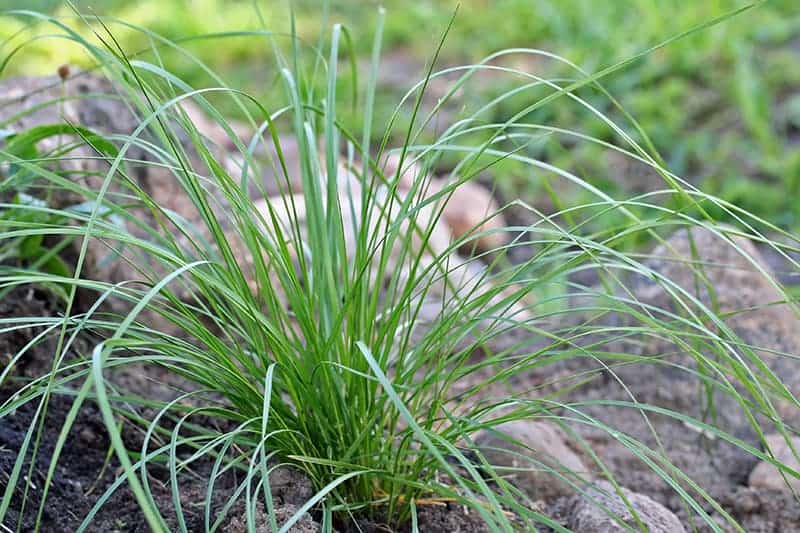
Scientific Name: Deschampsia cespitosa
Mature Size: Up to 3 feet tall
USDA Hardiness Zone: 4-9
Light: Full sun
Water: Average water needs
Soil: Rich, organic
Special Features: Drought tolerant once established
This semi-evergreen grass is low-growing, forming dense clumps of slender blades, up to two feet in height. In early summer, stems of up to three feet tall rise above the grass, producing feathery flowers in a dark purple shade, which fade to tan in winter. It is native to North America and is a low maintenance grass that fares well in a range of conditions. Though it prefers full sun, it will also adapt well to semi-shaded positions. Once established, this grass can gain tolerance to drought, and will thrive in almost any soil type, though it prefers organic soils.
4. Foxtail Barley
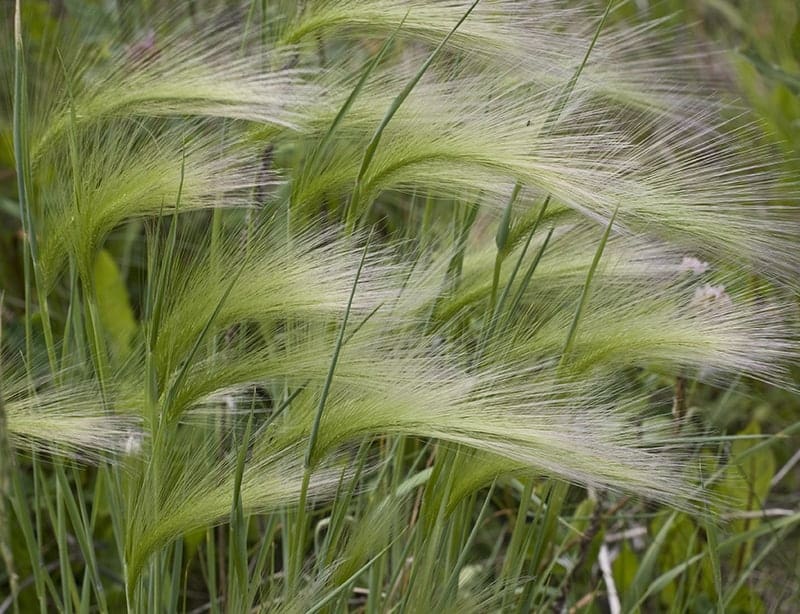
Scientific Name: Hordeum jubatum
Mature Size: Up to 2 feet tall
USDA Hardiness Zone: 4-10
Light: Full sun
Water: Average water needs
Soil: Average
Special Features: Tolerant of any soil type
This short-lived perennial grass is native to North America. It is clump-forming and produces silky, feather-like flowers that are tinged with bright pink and purple, then fading to a light tan color. These showy, tufted flowers give the grass its common name, as they resemble foxtails. The flowers can be seen in late spring through to summer, and are commonly used in dried and fresh cut-flower displays. This grass is very low maintenance and will grow in any soil type. It is often found growing in wet, soggy soils, but will also tolerate drought equally well. While it is not fussy about soil, it does have a lighting preference and performs best in full sun.
5. Purple Moor Grass
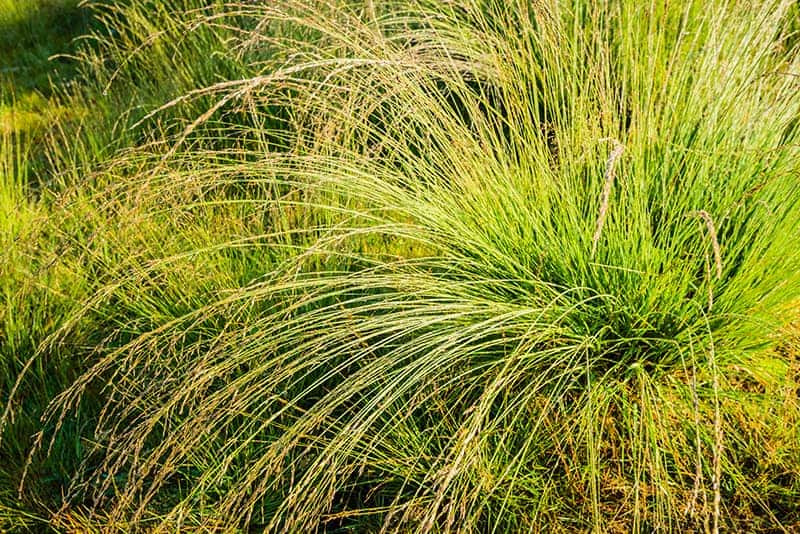
Scientific Name: Molinia caerulea
Mature Size: Up to 8 feet tall
USDA Hardiness Zone: 5-8
Light: Full sun to partial shade
Water: Average water needs
Soil: Acidic, well-draining
Special Features: Tolerates any soil type
Varieties: Molinia caerulea ‘Sky Racer’, Molinia caerulea ‘Transparent’, Molinia caerulea ‘Karl Foester’
This perennial grass is native to parts of Europe, Africa, and Asia. It has flat, coarse leaves that can grow up to eight feet tall, and gently arch to create a fountain look. The leaves start out green, developing to purple, and finally gold. It forms dense clumps of grass, typically measuring between two and four feet wide. Flowers bloom in late summer through to early fall. This grass is often found growing wild in boggy conditions, alongside streams or ponds. It enjoys moist to wet well-draining soil, though it is also drought tolerant once established, making it incredibly versatile in terms of where it can be grown. It can self-seed and will naturalize easily in ideal conditions.
6. Fountain Grass
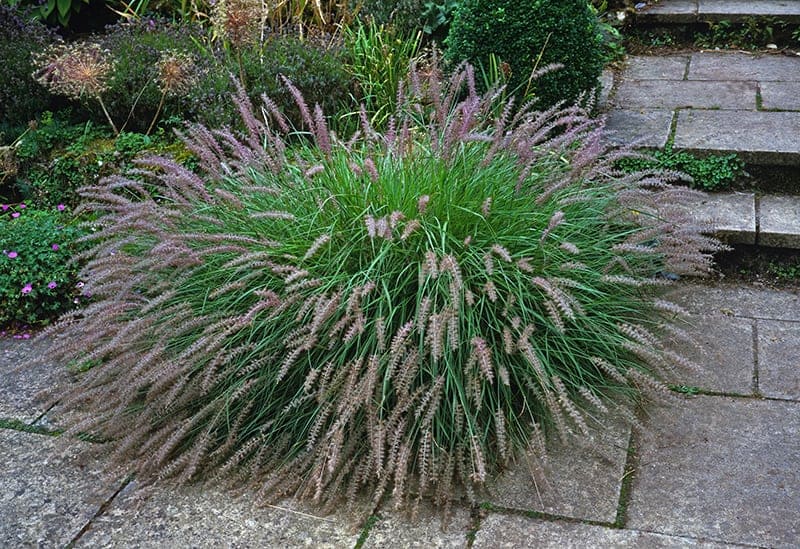
Scientific Name: Pennisetum alopecuroides
Mature Size: Up to 5 feet tall
USDA Hardiness Zone: 6-9
Light: Full sun to partial shade
Water: Low water needs
Soil: Well-draining
Special Features: Drought tolerant
Varieties: Pennisetum alopecuroides ‘Burgundy Bunny’, Pennisetum alopecuroides ‘Red Head’, Pennisetum alopecuroides ‘Desert Plains’
This perennial clump-forming grass grows in cascading mounds that look like fountains and is native to Australia and Asia. It comes in a range of sizes depending on variety, with some dwarf varieties reaching a maximum of just twelve inches, while taller varieties can grow to five foot high. The most common varieties usually sit at around three feet. This is a very easy-care grass that performs well in a range of conditions. It prefers dry soils and is considered drought tolerant once mature, though it will also grow well in wet soils, making it suitable for planting near rivers and streams. This grass produces flowers from late summer through to fall; they have a bushy fox tail look about them and can vary in color from pink to gold. This grass loves full sun and will produce the most abundant flowers in these conditions; however, it will adapt to partial shade.
7. Mexican Feather Grass
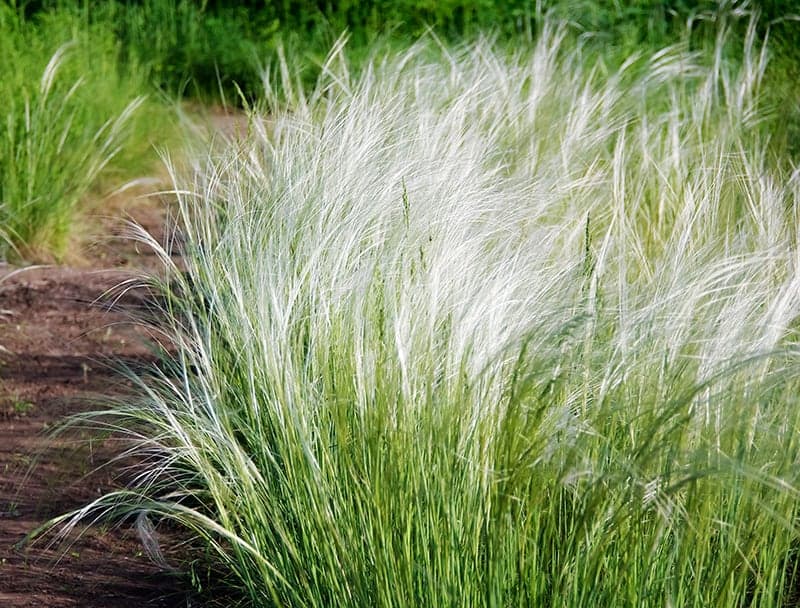
Scientific Name: Stipa tenuissima
Mature Size: Up to 2 feet tall
USDA Hardiness Zone: 7-11
Light: Full sun
Water: Low water needs
Soil: Fertile, well-draining
Special Features: Very fine, soft grass
This perennial grass is native to North and South America and forms dense clumps. It has a dreamy quality about it, with cotton-like foliage that sways in the most gentle breeze. The fine leaves are green in the summer, fading to light tan in the fall. At a maximum height of two feet tall, this grass works well amongst a wide range of plants, including flowering bulbs. It is well suited to container growth, as well as flower beds and borders, and wildflower gardens. This plant self-sows easily in ideal conditions and requires very little care. It can be grown from seed, or large clumps can also be divided in spring to create new smaller clumps. This grass loves full sun and performs best in fertile, well-draining soil. It likes fairly dry or slightly moist soil, but will not tolerate soggy soil conditions like some ornamental grasses.
8. Japanese Sedge
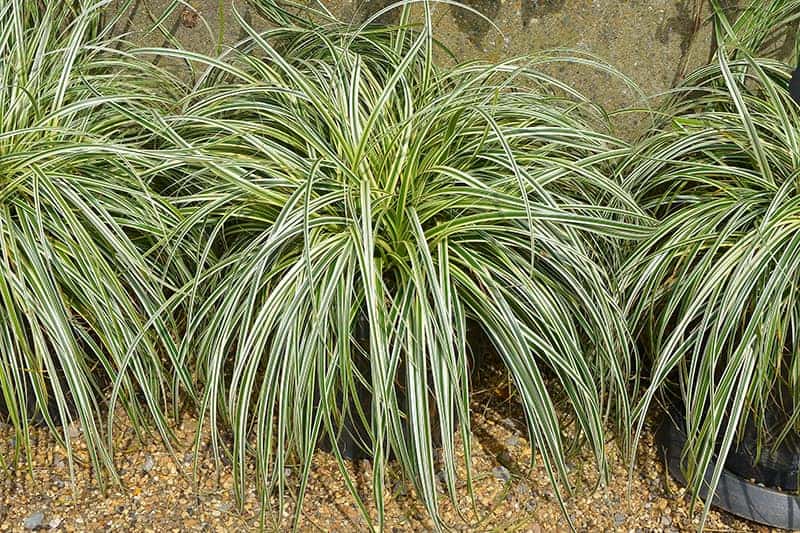
Scientific Name: Carex oshimensis
Mature Size: Up to 2 feet tall
USDA Hardiness Zone: 5-9
Light: Full sun to partial shade
Water: Average water needs
Soil: Well-draining
Special Features: Easy care
Varieties: Carex oshimensis ‘Evergold’, Carex oshimensis ‘Everlite’, Carex oshimensis ‘Eversheen’
This plant can be deciduous or perennial and forms low growing compact clumps. The foliage is long and sword-shaped, arching downwards to form a cascading mass. This plant works especially well in containers where it’s foliage can hang down below soil level, giving an almost trailing effect. Many varieties of this ornamental grass are available, with most having some kind of color variegation. These varieties produce striped lengths of foliage, in shades of green, cream, and yellow. This plant grows best in moist soil, though it is not tolerant of soggy soil, so a well-draining growing medium is essential. Once established, it will tolerate short periods of drought but should not intentionally be allowed to dry out for too long. Aim to water the grass whenever the topsoil is dry to the touch.
9. Northern Sea Oats
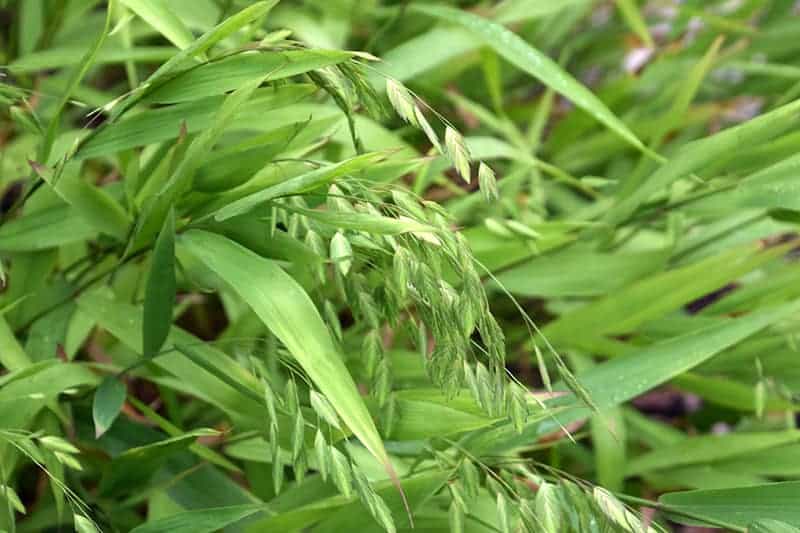
Scientific Name: Chasmanthium latifolium
Mature Size: Up to 5 feet tall
USDA Hardiness Zone: 3-8
Light: Full sun to partial shade
Water: Maintain moist soil
Soil: Well-draining
Special Features: Shade tolerant
This deciduous ornamental grass is native to the United States. It grows in clumps varying in height from two to five feet, with graceful upright stems, which are green in the spring and summer but develop to orange in the fall. It produces flowers that turn into drooping seed heads in late summer, and become tinted with purple later in the year. This elegant grass is tolerant of wet soils, making it ideal for planting in boggy land or by the side of ponds or streams, though it prefers medium moist, well-draining soils. It is one of the most shade tolerant of all ornamental grasses and will thrive in full sun or medium shade. It is an easy-care grass, though it should be cut back to the ground in early spring to make way for the new season’s growth.
10. Prairie Dropseed
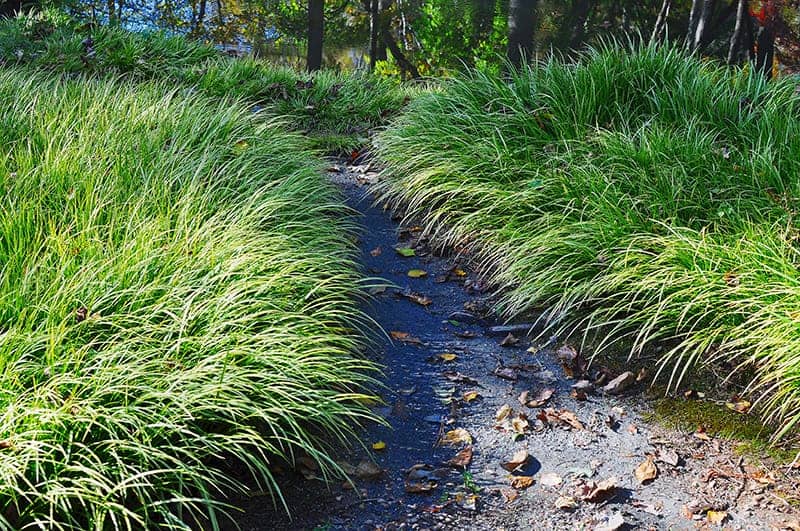
Scientific Name: Sporobolus heterolepis
Mature Size: Up to 3 feet tall
USDA Hardiness Zone: 3-9
Light: Full sun
Water: Low water needs
Soil: Well-draining
Special Features: Drought tolerant
This North American native forms circular decorative tufts from narrow arching foliage and is popularly grown in groups. The foliage reaches heights of around 18 inches, but the flowers rise above at up to three feet. The leaves offer year-round interest, being bright green in spring and summer before developing to orange in the fall, and finally golden brown in the winter. The fluffy flower heads are produced in late summer and have a strong scent similar to coriander. The seeds of the flowers drop to the ground in the fall, earning the grass the common name of ‘dropseed.’ This is a drought-tolerant ornamental grass, and so is ideal for use in rock gardens, or in borders and flower beds. It is not fussy about soil type and will grow in almost any soil that drains fairly well. In spite of dropping its seeds, this grass does not self-sow easily and so is not likely to spread or become invasive.
11. Big Bluestem
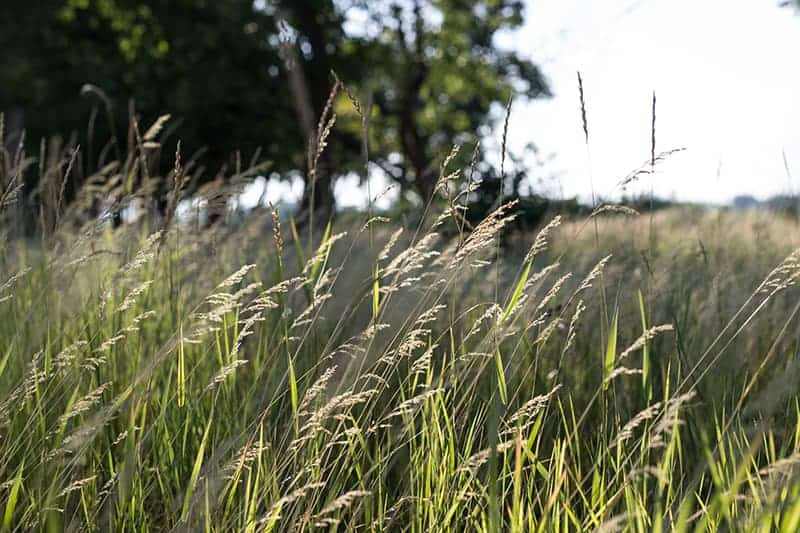
Scientific Name: Andropogon gerardii
Mature Size: Up to 6 feet tall
USDA Hardiness Zone: 4-9
Light: Full sun
Water: Average water needs
Soil: Poor to average, well-draining
Special Features: Drought tolerant
Varieties: Andropogon gerardii ‘Indian Warrior’, Andropogon gerardii ‘Blackhawks’
This long-lived perennial grass is native to North America and Mexico. The upright leaves emerge in a shade of blue-green, before developing to bright green over the course of a few weeks. As they age, they become orange, sometimes with a flush of purple. Clusters of flowers appear in late summer, which take the shape of purple turkey feet, and the grass is accordingly sometimes referred to as ‘turkey foot.’ With an average height of between four and six feet, this grass works well to add architectural height to a garden, as well as seasonal changing color. It self seeds easily in ideal conditions, which is typically in a full sun position amongst poor to average soil. Soil, which is too fertile, will cause this grass to become weak. The grass is also tolerant of drought, though it won’t do well in wet conditions, so it should be grown in well-draining soil.
12. Blue Grama
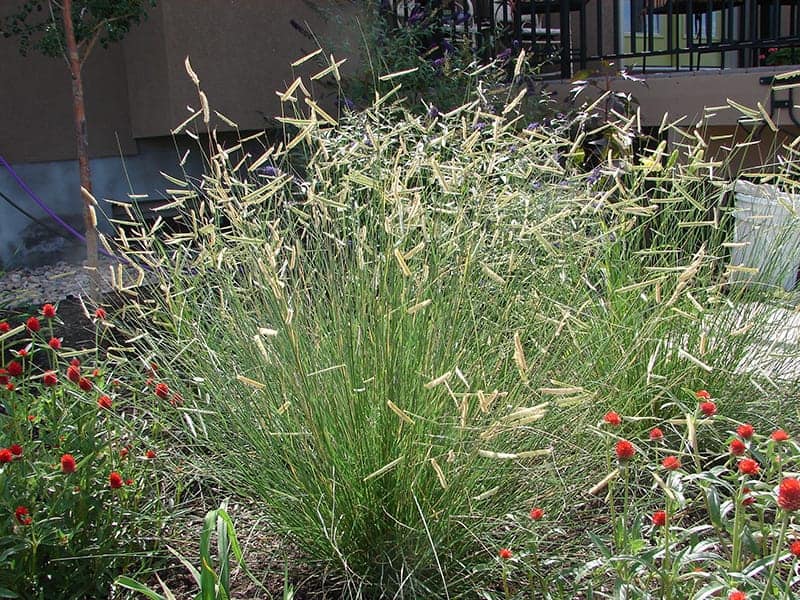
Scientific Name: Bouteloua gracilis
Mature Size: Up to 2 feet tall
USDA Hardiness Zone: 3-10
Light: Full sun
Water: Low water needs
Soil: Poor to average, well-draining
Special Features: Interesting blooms
Varieties: Bouteloua gracilis ‘Bad River’, Bouteloua gracilis ‘Blonde Ambition’, Bouteloua gracilis ‘Lovington’
This semi-evergreen grass is native to Mexico and the southern United States. It grows in dense, compact tufts, of between one and two feet in height. The foliage is blue-gray in color during the summer but develops to tan in the fall. The flowers appear in late spring and persist through to fall. They rise above the grass and look like curious miniature brushes. Each flower leans over horizontally, at a right angle to the stem it is joined onto. These flowers are red at first, then fade to pale orange. The flowers give way to seeds, which will disperse and self-sow easily, though they do not tend to become problematic and are easy to keep under control. This grass loves a full sun spot and performs best in poor to average soils. It is tolerant of drought and works well as a dried cut flower.
13. Papyrus
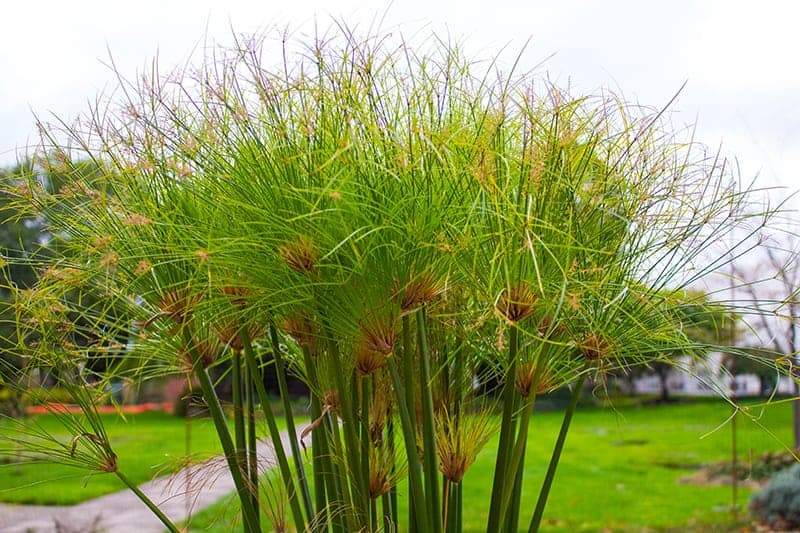
Scientific Name: Cyperus papyrus
Mature Size: Up to 12 feet tall
USDA Hardiness Zone: 10-11
Light: Full sun to partial shade
Water: Maintain wet soil
Soil: Wet
Special Features: Dramatic look
Varieties: Cyperus papyrus ‘King Tut’, Cyperus papyrus ‘Prince Tut’
This aquatic perennial is native to Africa and is famed for being the plant the Ancient Egyptians used to produce paper. This plant loves warm climates, though it can be grown in cooler areas and treated as an annual. It produces firm, upright, triangular stems, from which large umbels appear in an explosive fashion, looking like an array of green fireworks. Each umbel is made up of fine, thread-like strands that burst outwards to create a rounded shape. These eventually develop into brown fruits similar to nuts. As an aquatic plant, papyrus thrives in wet conditions. It can be planted alongside ponds or streams, in boggy terrain, or in a shallow tray which can be frequently topped up with water. It has a vigorous growth habit and reaches great heights quite rapidly. In its natural environment, it will grow to around twelve feet tall, whereas in home gardens, it usually tops out at between three and six feet.
14. Common Rush
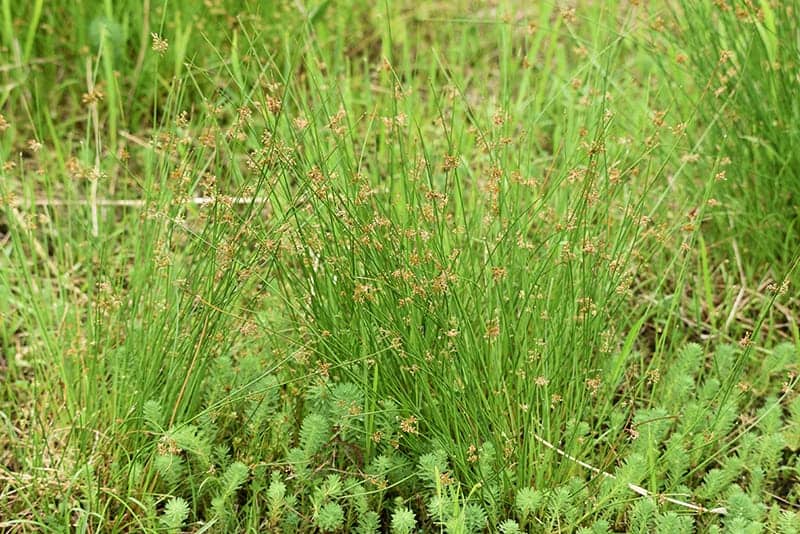
Scientific Name: Juncus effusus
Mature Size: Up to 4 feet tall
USDA Hardiness Zone: 4-9
Light: Full sun
Water: Maintain wet soil
Soil: Moist
Special Features: Cold hardy
This upright perennial grows natively across much of the globe, including Europe, Asia, North America, and Australia. It grows from rhizomes to produce clumps of rounded, vibrant green stems, which sit vertically and very gently fan outwards. In warm climates, the bright green color remains all year round, while in colder regions, it will fade to gold in the fall and brown in the winter. As a plant which thrives in wet soils, the common rush can be grown in boggy soils alongside streams and ponds, but can also be grown in standing water with a maximum depth of four inches. It self seeds easily, and large clumps can be propagated through division in spring or early summer. Common rush thrives in full sun.
15. Maiden Grass
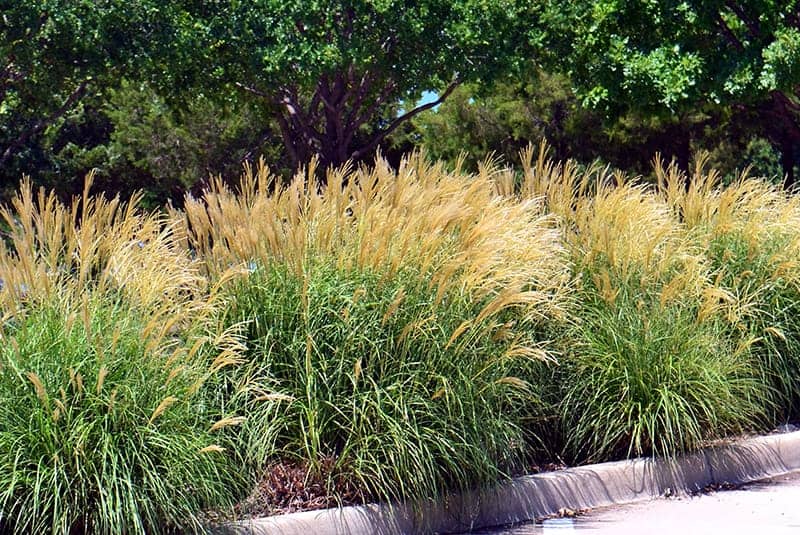
Scientific Name: Miscanthus sinensis
Mature Size: Up to 8 feet tall
USDA Hardiness Zone: 4-9
Light: Full sun to partial shade
Water: Average water needs
Soil: Fertile, well-draining
Special Features: Drought tolerant
Varieties: Miscanthus sinensis ‘Flamingo’, Miscanthus sinensis ‘Kaskade’, Miscanthus sinensis ‘Little Kitten’, Miscanthus sinensis ‘Morning Light’
This perennial grass, also commonly known as Japanese Silvergrass, is native to eastern Asia. This grass is noted for its feathery plumes, which are produced in abundance at various times throughout summer, depending on the variety. The plumes take various colors when they emerge, including pale pink, purple, and bright red. As the seasons wear on, these airy plumes fade to silver and provide interest throughout winter. This grass is deciduous and will die back in late winter. It should be cut back to the ground in early spring, giving space for new growth to emerge. While many varieties of this grass are sterile, it has become invasive in some parts of the US, and therefore it is recommended to use it with caution unless you are sure it is a sterile cultivar. This grass is drought tolerant and prefers a full sun position in well-draining soil.
16. Indian Grass
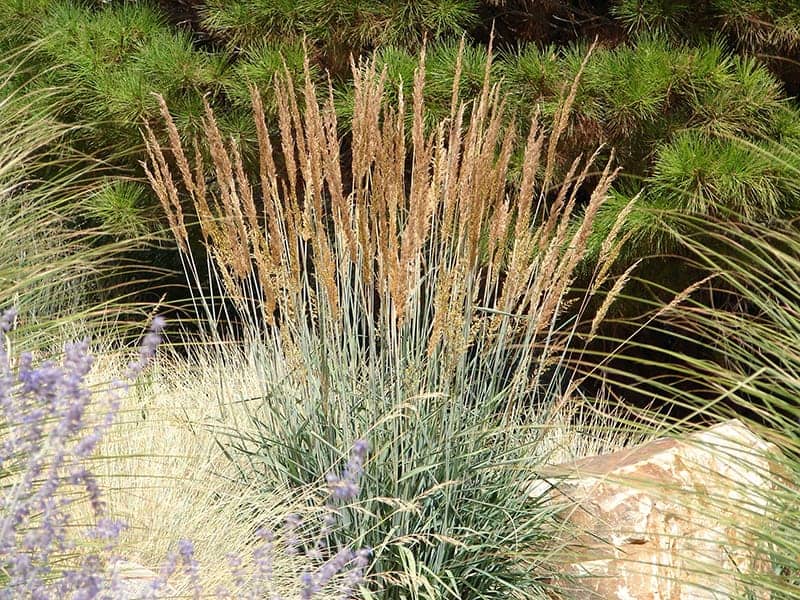
Scientific Name: Sorghastrum nutans
Mature Size: Up to 5 feet tall
USDA Hardiness Zone: 4-9
Light: Full sun
Water: Low water needs
Soil: Well-draining
Special Features: Tough and robust
This robust ornamental grass is native to the central and eastern United States, where it can be seen growing in abundance throughout the prairies. It is a perennial plant that forms dense clumps or gently arching upright gray-blue grass and will spread easily in ideal conditions through self-seeding. It blooms in late summer through to fall, with showy blooms that look soft and feathery. They are a pale copper color that develops to brown with age and is popularly used in dried flower arrangements. It is an easy-care grass with a strong root system which works well for erosion control. It is a hardy plant that can withstand most growing conditions, including drought, and it will also tolerate a wide range of soils, including clay and infertile soils. It will not survive in soggy conditions, and so well-draining soil is preferred.
